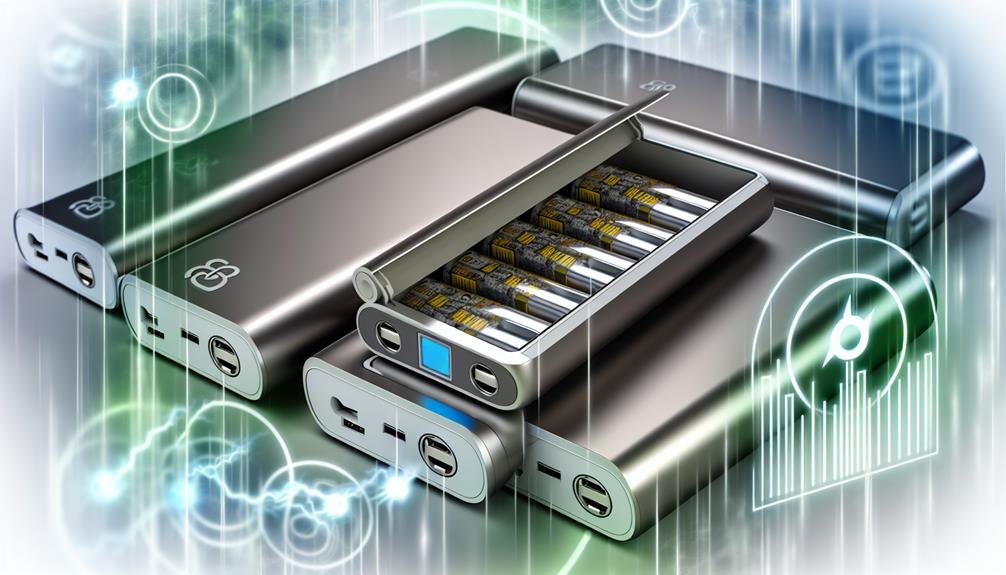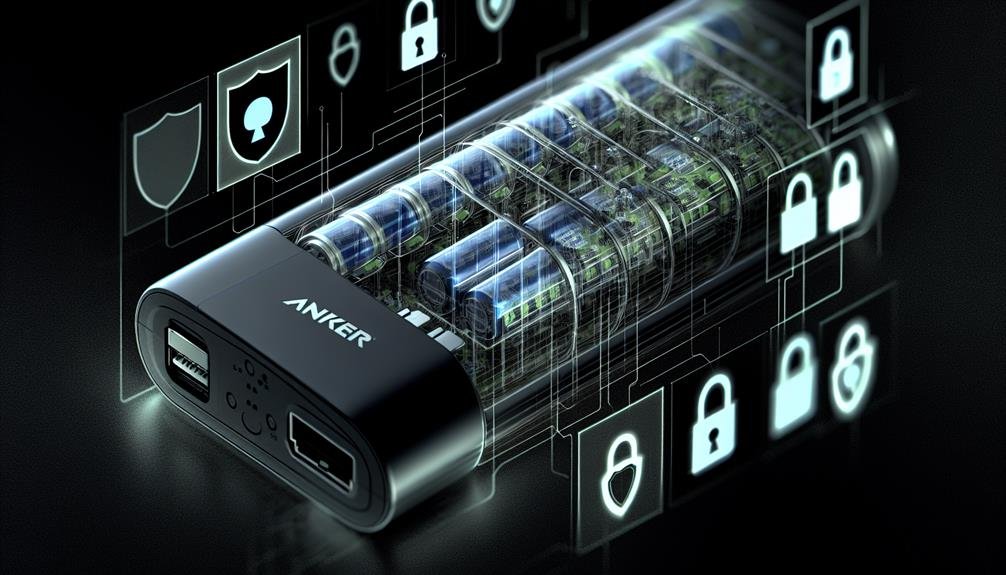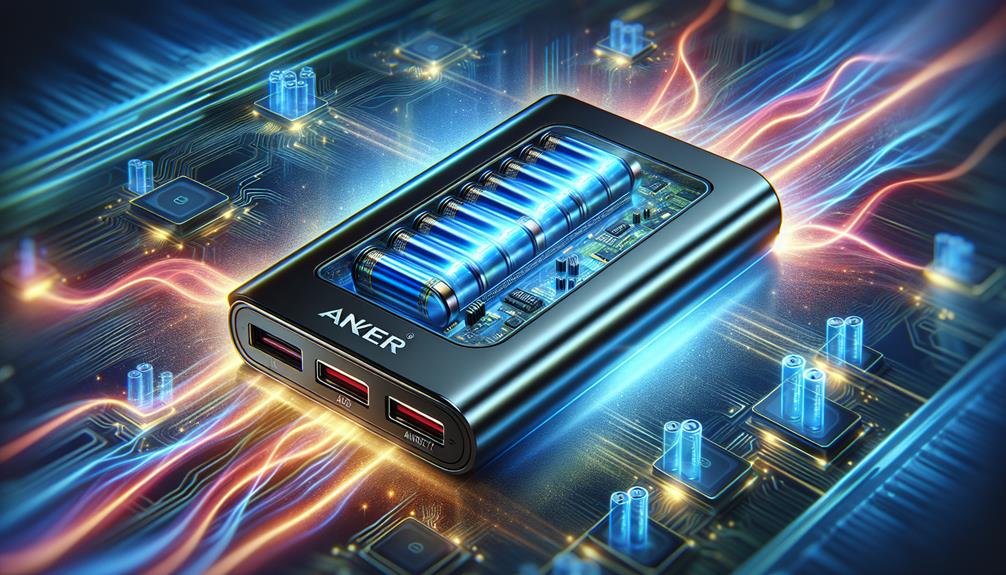Anker power banks feature either lithium-ion (Li-Ion) or lithium-polymer (Li-Po) batteries. Li-Ion offers high energy density, making it ideal for fast charging and portability. However, they're prone to thermal runaway, which is mitigated by Anker's advanced safety mechanisms. Li-Po batteries, though slightly bulkier, provide a stable, leak-resistant design. Both types guarantee efficient energy storage, high charge cycles, and low self-discharge rates. With features like overcharging protection and temperature control, Anker guarantees safety and performance. For a detailed comparison and complete understanding of their benefits, there's more to explore.
Types of Batteries in Anker Power Banks

Anker power banks typically utilize two main types of batteries: Lithium-Ion (Li-Ion) and Lithium-Polymer (Li-Po), each offering distinct advantages regarding energy density, durability, and cost-efficiency. Understanding these battery technologies can help you make informed decisions about your power needs and safety considerations.
Li-Ion batteries are renowned for their high energy density, which means they can store a significant amount of power capacity in a relatively small volume. This makes them ideal for users who prioritize charging speed and portability. However, Li-Ion batteries are prone to thermal runaway if not properly managed, so Anker incorporates advanced safety mechanisms to mitigate risks, such as overcharge protection and temperature control.
On the other hand, Li-Po batteries offer increased flexibility in design, enabling sleeker, more portable power banks. They're generally more stable and less likely to leak electrolytes, which enhances their overall safety profile. While Li-Po batteries might have a slightly lower energy density compared to Li-Ion, their durability and the capability for rapid charging make them a reliable choice for many users.
Advantages of Lithium-Based Batteries
Lithium-based batteries offer a high energy density, which means you can store a substantial amount of power in a compact form, making them ideal for portable electronic devices. This attribute greatly enhances the portability of devices like Anker power banks, allowing you to carry more energy without a bulky design.
When considering longevity, lithium-based batteries outperform many alternatives. They typically offer a higher number of charge cycles, meaning your Anker power bank will last longer before needing a replacement. This durability is vital for users who rely on consistent performance over time.
Additionally, lithium-based batteries exhibit a low self-discharge rate, which means they retain their charge longer when not in use. This is particularly advantageous if you need your power bank ready at a moment's notice.
Here are some key advantages of lithium-based batteries:
- High Energy Density: Maximizes energy storage in a minimal footprint.
- Longevity: Supports numerous charge cycles, enhancing the lifespan of the device.
- Low Self-Discharge: Maintains stored energy effectively over time.
- Portability: Lightweight and compact, perfect for on-the-go use.
Incorporating these features, Anker power banks leverage lithium-based batteries to provide efficient, durable, and portable power solutions for your electronic devices.
Safety Features in Anker Power Banks

One critical aspect to take into account is the suite of safety features integrated into Anker power banks, guaranteeing reliable and secure operation under various conditions. These devices come equipped with advanced overcharging protection, which prevents the battery from receiving excess charge once it reaches full capacity. This feature not only prolongs the lifespan of the power bank but also mitigates risks associated with overcharging, such as overheating and potential battery damage.
Furthermore, Anker power banks employ sophisticated temperature control mechanisms. These systems continuously monitor the internal temperature of the device, adjusting power flow to maintain an ideal thermal environment. If the temperature exceeds a certain threshold, the power bank will automatically reduce the charging rate or even shut down to prevent overheating. This ensures that the device remains within safe operating limits, protecting both the power bank and your connected devices from thermal damage.
Additionally, short-circuit protection and surge protection are standard in Anker power banks. These features guard against electrical anomalies, ensuring stable and secure charging. With these robust safety measures, you can confidently rely on Anker power banks for safe and efficient energy storage.
Performance and Efficiency
When evaluating the performance and efficiency of these power banks, it's essential to take into account their high-density lithium-ion cells and advanced power management technology, which together guarantee fast charging and efficient energy utilization. Anker's power banks are engineered to deliver best charging speed, ensuring your devices are powered up in minimal time. This rapid charging is facilitated by technologies like PowerIQ and VoltageBoost, which dynamically adjust output to match your device's requirements.
Efficiency extends beyond speed; it also encompasses battery lifespan. Anker integrates sophisticated circuitry to minimize energy loss during charging and discharging cycles, thereby extending the overall life of the power bank. This not only ensures long-term reliability but also enhances safety by reducing the risk of overheating and overcharging.
Key features contributing to performance and efficiency:
- PowerIQ Technology: Automatically identifies connected devices to deliver the fastest possible charge.
- VoltageBoost: Compensates for cable resistance, maintaining best charging speed.
- MultiProtect Safety System: Offers surge protection, short circuit prevention, and more advanced safety features.
- High-Density Lithium-Ion Cells: Provide a higher energy output and longer lifespan compared to traditional cells.
Comparing Lithium to Other Battery Types

Delving into the intricacies of battery technology, it's important to compare the high energy density and longevity of lithium-ion cells against the lower efficiency and shorter lifespan of traditional nickel-cadmium and nickel-metal hydride batteries. Lithium-ion batteries, which power Anker power banks, offer superior battery longevity and a reduced environmental impact due to their enhanced efficiency and longer life cycles. Unlike nickel-cadmium batteries, which suffer from memory effect and require frequent maintenance, lithium-ion cells provide consistent performance with minimal degradation over time.
Charging speed is another critical factor. Lithium-ion batteries support rapid charging protocols, notably reducing downtime. This advantage ensures quicker recharging of your Anker power bank, enabling you to get back to using your devices sooner. On the other hand, nickel-based batteries often have slower charging speeds and are less compatible with modern fast-charging technologies.
In terms of compatibility, lithium-ion batteries are more versatile and can be integrated into a wide range of devices without compromising safety or performance. Nickel-metal hydride and nickel-cadmium batteries, however, have compatibility issues with newer technologies and are less efficient in energy storage and delivery. Consequently, for both safety and efficiency, lithium-ion remains the superior choice.
Frequently Asked Questions
How Long Do Anker Power Banks Typically Last on a Single Charge?
You'll find that Anker power banks excel in charging efficiency and battery life. Depending on the power bank capacity and charging speed, they typically last between one to seven days on a single charge, ensuring reliable performance.
Can Anker Power Banks Charge Laptops and Other High-Power Devices?
Yes, Anker power banks can charge laptops and other high-power devices, thanks to their high charging capacity and compatibility. They incorporate advanced technology and robust power bank safety features to guarantee reliable and secure charging.
Are Anker Power Banks Compatible With All Smartphone Brands?
You might wonder if Anker power banks are compatible with all smartphone brands. They are, thanks to universal charging protocols. Enjoy quick charging speeds and excellent portability, ensuring your devices stay powered up safely and efficiently.
How Long Is the Warranty Period for Anker Power Banks?
The warranty coverage for Anker power banks typically spans 18 months. This guarantees you're protected against defects affecting battery lifespan, offering peace of mind and enhanced safety for your device's longevity. Always check specific model details.
What Is the Average Cost of an Anker Power Bank?
Imagine you're exploring a tech jungle; an Anker power bank's features are your survival gear. On average, these lifelines cost $30-$60. For safety, consider alternatives like RavPower, balancing cost and quality in your toolkit.



